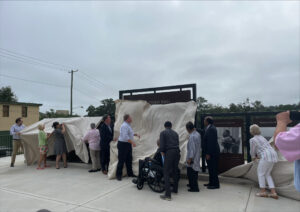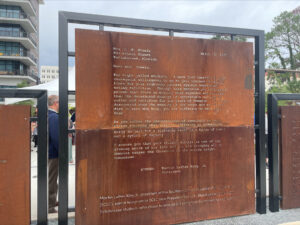
North American Properties (NAP), the initial developer of Cascades Park, unveiled two monuments this morning at the new Cascades Historical Plaza.
Since 2017, city officials and historians have been meeting regularly to discuss plans for building the displays after NAP promised to highlight the city’s untold history.
What once was the Leon County jail on Gaines Street is now the home of the civil rights monument. The prison gained attention in the 1960s after civil rights activists were thrown in jail after refusing to pay a $300 bail for holding a non-violent protest against segregation.
The exhibit stands over eight feet tall, with a width of over 30 feet. The structure is made of corten steel and has a dark rust color.
“We made the memorial out of corten steel which lasts forever,” Shawn McIntyre, NAP’s managing partner for Florida, said. “That’s the whole idea that this history will last forever.”
The monument is double-sided, with 14 panels in total. The six smaller panels on the front display pictures with captions below, describing the events leading up to the jail-in. On the back of the middle panel is a replication of a letter that Dr. Martin Luther King Jr. wrote to the activists while they were in jail in 1960.

There were many different organizers for this project, from city officials to activists who spent nights sleeping on the original jail floor.
“When we started this process, the only people who knew the significance of this area were the ones who had lived through it,” Althemese Barnes, founder of the John G. Riley House and Museum and a member of the Cascades Historical User Group, said.
A vital organizer on the team to help bring this idea to life was the Rev. Henry Marion Steele. He was one of the activists arrested during the protest. He was 16 years old at the time.
“The fact that they put emphasis on my story and what we were trying to do back then,” Steele said. “It means a lot to me.”
The second smaller exhibit in the plaza depicts Tallahassee’s “Four Corners of History,” a reference to the significant Art Moderne architectural heritage sits at the intersection of East Gaines and South Gadsden. The historical structures included on display are the Old City Waterworks, the Caroline Brevard Grammar School (the former Leon County Health Unit), and the former jail site.
“Although not everything remains,” Jennifer Koslow, a Cascades Historical User Group member, said. “It is a pleasure to see several buildings preserved and re-adapted for new purposes.”
The memorial can be found at the corner of Gaines and South Gadsden streets.